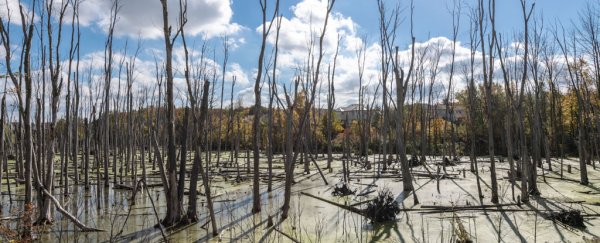Ghost forests could be an invisible source of greenhouse gas emissions, researchers warn.
As rising seas poison trees along the Atlantic coast of the United States, a new study suggests these ghost trees are beginning to 'fart' carbon dioxide and methane.
Technically, all trees do a little bit of farting. Live trees are known to release small amounts of methane and other gases into the atmosphere from their trunks, and yet in exchange, they also store a lot of carbon.
Standing dead trees, also called snags, have been killed by saltwater intrusion, which means they no longer have a leaf canopy to photosynthesize and consume carbon dioxide. As such, they can potentially increase the ecosystem's carbon dioxide emissions by up to 25 percent.
Unlike live trees, snags are not actively moving water and nutrients around for growth, which means the gases they emit are probably coming from decaying wood or diffusing up from the soil below along a water gradient.
In other words, ghost trees could be acting like giant straws stuck in the salt marsh, sucking greenhouse gases out of the ground and emitting greenhouse gases into the atmosphere.
"We think that they act as straws, but as a filtered straw," explains forestry scientist Marcelo Ardón from NC State.
"They change those gases, as the gases move through the snags."
Using portable gas analyzers, researchers measured emissions from the soil and ghost trees of five regions in North Carolina currently experiencing severe saltwater intrusion.
Across two summers, in 2018 and 2019, the team found the soil produced four times more greenhouse gas emissions than standing dead trees.
"Even though these standing dead trees are not emitting as much as the soils, they're still emitting something, and they definitely need to be accounted for," says environmental scientist Melinda Martinez from North Carolina State.
"Even the smallest fart counts."
In tropical wetlands, where the soil is waterlogged, live trees often release more significant methane farts, but among dead trees standing in saltwater marshes, carbon dioxide appears to be the main greenhouse gas that is released.
In the current study, water conditions and salt levels in the marshes had a clear impact on the emissions coming from the soil. But it was harder to say how these conditions affected the emissions of ghost trees.
Further research is needed so that we can put a proper number on ghost tree emissions and predict what might happen to these dead forests in the future.
As sea levels continue to rise rapidly, ghost forests are bound to spread, and we need to know what impact that will ultimately have on local and global emissions.
"The transition from forest to marsh from these disturbances is happening quickly, and it's leaving behind many dead trees," says Martinez.
"We expect these ghost forests will continue to expand as the climate changes."
The study was published in Biogeochemistry.
